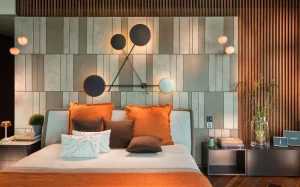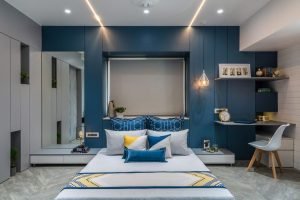Your bedroom is more than just a place to sleep – it is your sanctuary, your haven from the chaos of the outside world. It should be a space that reflects your personal style and fosters relaxation and rejuvenation. But how do you go about designing the perfect bedroom? From choosing the right color palette to selecting furniture that fits both your needs and aesthetic preferences, there are numerous elements to consider when creating a functional and beautiful space. In this article, we will explore practical tips and creative ideas on how to design a bedroom that truly feels like home.
The importance of a well-designed bedroom
A well-designed bedroom is not only aesthetically appealing but also plays a crucial role in promoting relaxation and restful sleep. The layout, colors, lighting, and overall ambiance of the space can significantly impact our quality of sleep and even our mood when we wake up in the morning. Creating a bedroom that is tailored to our individual needs and preferences can help us unwind after a long day, reduce stress levels, and ultimately improve our overall well-being.
One key aspect of designing a functional bedroom is considering furniture placement. By strategically arranging pieces such as the bed, nightstands, and dressers, we can create an optimal flow within the room while maximizing space efficiency. This not only enhances the visual appeal but also improves functionality by ensuring easy access to essential items. Additionally, color selection is another factor that should not be overlooked. Different colors have varying psychological effects on our minds. For instance, cool tones like blues and greens promote tranquility and calmness while warmer hues like reds or oranges can energize or stimulate senses. By carefully selecting colors for walls, bedding, and accessories in accordance with personal preferences and desired atmosphere goals (e.g., creating a peaceful sanctuary or an invigorating haven), we can transform our bedrooms into havens that cater specifically to our needs.

Assessing your needs and preferences
Assessing your needs and preferences is a crucial step in designing the perfect bedroom. Before diving into color schemes, furniture choices, or decor options, take some time to evaluate what you truly want and need from your personal sanctuary. Start by considering the purpose of your bedroom. Is it solely for sleeping or do you also use it as a workspace or a relaxation area? Understanding how you use the space will help guide your design decisions.
Next, think about your personal preferences and style. Do you gravitate towards clean lines and minimalism or are you drawn to bold colors and patterns? Take inspiration from different sources such as magazines, websites, or even nature to get an idea of what resonates with you. Don’t be afraid to mix styles or incorporate contrasting elements to create a unique space that reflects your personality. Lastly, consider any specific needs that may affect the functionality of your bedroom. If you have allergies or sensitivities, opt for hypoallergenic bedding materials or choose flooring that is easy to clean and maintain. If storage is a concern, look for creative solutions such as under-bed drawers or built-in wall units.
Choosing the right color scheme
Choosing the right color scheme for your bedroom is a crucial part of creating a relaxing and inviting space. While some may opt for bold and vibrant colors, it’s essential to consider the impact that different hues can have on our mood and overall sleep patterns. For instance, studies suggest that blue is associated with calmness and relaxation, making it an excellent choice for bedrooms. Shades of green also promote a sense of tranquility and harmony, while warm neutrals like beige or light brown create a feeling of comfort and cosiness.
In addition to considering the psychological effects of color, it’s important to keep in mind the size and natural lighting of your bedroom when choosing a color scheme. If you have a smaller room or limited natural light, lighter shades can make the space appear more spacious and airy. Conversely, darker colors can add depth and warmth to larger rooms with abundant sunlight streaming in. Ultimately, the right color scheme will depend on personal preference and desired ambiance. Experimenting with different combinations can help you find the perfect balance between style, comfort, and relaxation in your bedroom sanctuary. Remember that colors evoke emotions, so choose wisely to create an atmosphere that promotes restful sleep and reflects your unique personality.

Selecting furniture and accessories
When it comes to designing your bedroom, selecting the right furniture and accessories is crucial in creating a space that reflects your personal style. Start by assessing the size of your room and considering the layout options available to you. Opt for furniture pieces that are proportionate to the size of your bedroom, ensuring they don’t overwhelm or overcrowd the space.
In terms of accessories, don’t be afraid to get creative and add personality to your bedroom. Instead of sticking with traditional artwork, consider hanging up floating shelves and displaying a collection of unique trinkets or sentimental items. Incorporating plants into your bedroom can also bring a fresh and calming atmosphere. Additionally, don’t overlook the importance of lighting – choose fixtures that not only provide adequate illumination but also enhance the overall design aesthetic. Remember, selecting furniture and accessories is an opportunity to infuse individuality into your bedroom design. Take time to explore different styles, consider functionality, and let yourself be inspired by various decorative elements before making final decisions. With thoughtfulness and attention to detail, you can create a stunning and truly personalized oasis in which you feel at ease.
Maximizing storage and organization solutions
The key to a well-designed and organized bedroom lies in maximizing storage solutions. When it comes to creating the perfect space, it’s important to consider both form and function. Look for furniture pieces that not only provide storage, but also add visual interest to the room. For example, opt for a bed frame with built-in drawers or shelves that can hold extra blankets or books. Additionally, consider utilizing vertical space by installing floating shelves or wall-mounted organizers for items such as jewelry or accessories.
Another great way to maximize storage in your bedroom is through the use of multi-functional furniture. Look for pieces that serve more than one purpose, such as ottomans with hidden compartments or bedside tables with built-in charging stations. This allows you to keep your essentials within reach while reducing clutter in the room. When organizing your belongings, think about categorizing items based on frequency of use. Keep everyday essentials easily accessible while storing seasonal items or specialty tools out of sight. Utilize bins and baskets that can be tucked away under the bed or inside closets to store items you don’t regularly need.
Conclusion: Creating your dream bedroom
In conclusion, creating your dream bedroom is a deeply personal and satisfying endeavor. It’s about more than just picking out furniture or choosing paint colors; it’s about designing a space that reflects your unique personality and meets your specific needs. Whether you prefer minimalism or maximalism, bright colors or soothing neutrals, remember to always prioritize comfort and functionality.
One of the most important aspects of designing the perfect bedroom is paying attention to lighting. Adequate lighting can completely transform the mood of a room, so consider incorporating different sources such as overhead fixtures, task lamps for reading or working, and ambient lighting for relaxation. Additionally, don’t underestimate the power of textiles in creating a cozy atmosphere. Opt for plush bedding, soft rugs underfoot, and window treatments that provide both privacy and style.
